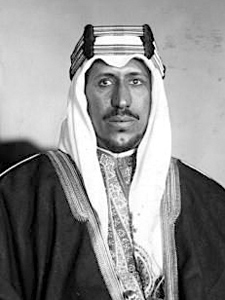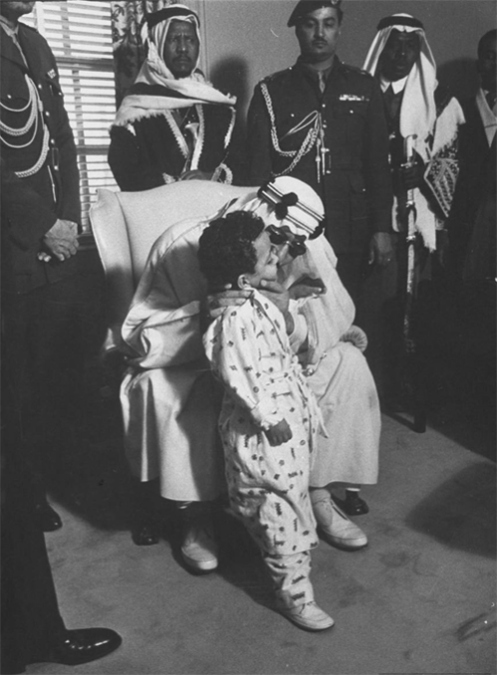by Susan Flantzer
© Unofficial Royalty 2020

King Saud of Saudi Arabia; Credit – Wikipedia
Arabic Naming Conventions
- Al – family/clan of…
- bin or ibn – son of…
- bint – daughter of…
Saud bin Abdulaziz Al Saud, the second King of Saudi Arabia, was born on January 15, 1902, in Kuwait City, Kuwait while the Al Saud family was in exile. His father was Abdulaziz ibn Abdul Rahman Al-Saud, also known as Ibn Saud, the founder and the first king of Saudi Arabia. Saud’s mother, Wadhah bint Muhammad bin Hussein Al-Orair (died 1969) from the Qahtan tribe, was his father’s second of many wives. Abdulaziz’s first wife died six months after her marriage. Abdulaziz had a polygamous household comprising several wives at a time and numerous concubines. It is thought he had a total of 22-24 wives. Abdulaziz was the father of almost a hundred children, including 45 of whom 36 survived to adulthood.
In 1902, the year of Saud’s birth, his father Abdulaziz recaptured control of Riyadh, bringing the city under the control of the Al Saud. For the next 24 years, Abdulaziz consolidated the territory of the Arabian peninsula. In 1926, Abdulaziz reached his goal and was then King of the dual Kingdoms of Hejaz and Nejd. On September 23, 1932, the two kingdoms of the Hejaz and Nejd were united as the Kingdom of Saudi Arabia. On May 11, 1933, Abdulaziz appointed his eldest surviving son Saud as Crown Prince of Saudi Arabia.

Saud’s brother Turki who died at the age of 18; Credit – Wikipedia
Saud had five full siblings. His elder brother Turki bin Abdulaziz Al Saud died in 1919 at the age of 18 during the influenza pandemic of 1918-1920.
- Turki I bin Abdulaziz Al Saud (1900 – 1919)
- Khalid bin Abdulaziz Al Saud (died young)
- Munira bint Abdulaziz Al Saud(died 1972)
- Nura bint Abdulaziz Al Saud
- Abdullah bin Abdulaziz Al Saud (died young)
Saud had many half-siblings, too numerous to list here. See Wikipedia: Descendants of Ibn Saud (Abdulaziz). The six Kings of Saudi Arabia who followed King Abdulaziz were all his sons and so five of them were the half-brothers of Saud. King Saud succeeded his father King Abdulaziz and was succeeded by his half-brother, King Faisal who had deposed him.
- King Faisal of Saudia Arabia (1906 – 1975, reigned 1964 – 1975, assassinated)
- King Khalid of Saudi Arabia (1913 – 1982, reigned 1975 – 1982)
- King Fahd of Saudi Arabia (1921 – 2005, reigned 1982 – 2005)
- King Abdullah of Saudi Arabia (1924 – 2015, reigned 2005 – 2015)
- King Salman of Saudi Arabia (born 1935, reigned 2015 – present)
Saud was brought up in a home that included his parents, his brothers, and his paternal grandparents Abdul Rahman bin Faisal Al-Saud and Sarah bint Ahmed Al-Sudairy. Saud and his older brother Turki were very close. Their paternal grandparents had a great impact on their upbringing. When he was five-years-old, Saud began studying Sharia law and the Quran. Under the supervision of his father Abdulaziz, Saud learned archery, horse-riding, tribal lineages, and the art of wars, politics, diplomacy, and administration in the traditional Arabian ways. From an early age, Saud accompanied his father on war-related, political, administrative, and diplomatic missions. Eventually, Abdulaziz entrusted Saud to conduct these missions on his own. In 1915, thirteen-year-old Saud led his first political mission delegation to Qatar and fought in his first battle.

King Saud with his son Prince Mashhoor in 1957; Credit – Wikipedia
Saud had an estimated 115 children and many wives, too numerous to list here. See Wikipedia: Wives and Children of King Saud.
During the reign of his father King Abdulaziz, Saud and his half-brother Faisal, who was four years younger and succeeded Saud as King of Saudi Arabia, had great responsibilities in the establishment and operation of the new kingdom. On October 13, 1953, Saud was appointed Prime Minister of Saudi Arabia. A month later, on November 9, 1953, King Abdulaziz died in his sleep from a heart attack with his son Prince Faisal, a future King of Saudi Arabia, at his bedside. In his will, King Abdulaziz stipulated that his sons should respect their different maternal ties, never turn against one another, and respect Islam and Wahhabi teachings. The kingdom was to be brought into modern times without destroying traditional values.
Embed from Getty Images
Saud’s half-brother Faisal as Crown Prince in 1957
Prince Faisal had served as his father’s Foreign Minister beginning in 1930. Upon the death of his father King Abdulaziz and the accession of his half-brother King Saud in 1953, Faisal was appointed Crown Prince. King Saud remained Prime Minister and Faisal was appointed Deputy Prime Minister as well as continuing as Foreign Minister. However, unrest within the royal family over King Saud’s rule forced him to appoint Faisal as Prime Minister. An ongoing power struggle between the two half-brothers led to Faisal’s resignation as Prime Minister and Foreign Minister in 1960. The continued discontent with King Saud’s reign allowed Faisal to become Prime Minister and Foreign Minister again in 1962.
During his reign, King Saud was responsible for creating numerous government ministries and the creation of King Saud University in the capital city of Riyadh. Saud wanted to empower his 53 sons by placing them in government positions. This upset his many half-brothers, who thought that Saud’s sons were too inexperienced, and they began to fear that he would select one of his sons to succeed him. Saud was also seen to use large sums of state funds for his own family and palaces at a time when Saudi Arabia was struggling to rise economically.
Embed from Getty Images
King Saud with American President Dwight Eisenhower
King Saud and Crown Prince Faisal continued their power struggle when, in 1962, Prince Faisal formed a cabinet in the absence of King Saud, who had gone abroad for medical treatment. Faisal allied himself with his half-brothers Prince Fahd bin Abdulaziz Al Saud, the Interior Minister and the future King of Saudi Arabia, and Prince Sultan bin Abdulaziz Al Saud, the Minister of Defense (from 1963 until his death) and the Crown Prince from 2005 until he died in 2011. The new government excluded any sons of King Saud.
When King Saud returned to Saudi Arabia, he threatened to mobilize the Royal Guard against his half-brother. In response, Faisal demanded King Saud make him regent and turn over all royal powers to him. Faisal had the support of the ulema, the elite Islamic scholars. Muhammad ibn Ibrahim Al ash-Sheikh, the Grand Mufti of Saudi Arabia, a relative of Faisal on his mother’s side, issued a fatwa saying King Saud should accede to Faisal’s demands. When King Saud refused, Faisal ordered the National Guard to surround Saud’s palace. In March 1964, Saud finally agreed to name Faisal regent with full executive powers, reducing himself to a figurehead. In November 1964, the ulema, the cabinet, and senior members of the Saudi royal family forced Saud to abdicate and Faisal became king in his own right.
Embed from Getty Images
Former King Saud with his daughter Princess Nazha bint Saud, his baby grandson Prince Abdulaziz, and an unnamed child on the left, October 10, 1968
Saud was forced into exile but lived quite comfortably with a retinue of forty people. He first settled in Geneva, Switzerland, then lived in palaces in Paris, France and the French Riviera. Saud then settled in Egypt in a magnificent palace in Heliopolis, and then in Greece at a large estate in Athens. On February 23, 1969, former King Saud died in Athens at the age of 67 after suffering a heart attack in his sleep. His body was taken back to Saudi Arabia where the funeral ceremony took place at the Great Mosque in Mecca. He was quietly buried next to his father at Al Oud cemetery in Riyadh.

Al Oud cemetery – burials are in unmarked graves covered with mounds of stones; Credit – timenote.info
This article is the intellectual property of Unofficial Royalty and is NOT TO BE COPIED, EDITED, OR POSTED IN ANY FORM ON ANOTHER WEBSITE under any circumstances. It is permissible to use a link that directs to Unofficial Royalty.
Works Cited
- Ar.wikipedia.org. 2020. أسرة سعود بن عبد العزيز آل سعود. [online] Available at: <https://ar.wikipedia.org/wiki/%D8%A3%D8%B3%D8%B1%D8%A9_%D8%B3%D8%B9%D9%88%D8%AF_%D8%A8%D9%86_%D8%B9%D8%A8%D8%AF_%D8%A7%D9%84%D8%B9%D8%B2%D9%8A%D8%B2_%D8%A2%D9%84_%D8%B3%D8%B9%D9%88%D8%AF> [Accessed 2 September 2020].
- Ar.wikipedia.org. 2020. سعود بن عبد العزيز آل سعود. [online] Available at: <https://ar.wikipedia.org/wiki/%D8%B3%D8%B9%D9%88%D8%AF_%D8%A8%D9%86_%D8%B9%D8%A8%D8%AF_%D8%A7%D9%84%D8%B9%D8%B2%D9%8A%D8%B2_%D8%A2%D9%84_%D8%B3%D8%B9%D9%88%D8%AF> [Accessed 2 September 2020].
- De.wikipedia.org. 2020. Saud Ibn Abd Al-Aziz. [online] Available at: <https://de.wikipedia.org/wiki/Saud_ibn_Abd_al-Aziz> [Accessed 2 September 2020].
- En.wikipedia.org. 2020. Saud Of Saudi Arabia. [online] Available at: <https://en.wikipedia.org/wiki/Saud_of_Saudi_Arabia> [Accessed 2 September 2020].
- Es.wikipedia.org. 2020. Saúd Bin Abdulaziz. [online] Available at: <https://es.wikipedia.org/wiki/Sa%C3%BAd_bin_Abdulaziz> [Accessed 2 September 2020].
- Flantzer, Susan, 2020. King Abdulaziz Of Saudi Arabia. [online] Unofficial Royalty. Available at: <https://www.unofficialroyalty.com/king-abdulaziz-ibn-saud-of-saudi-arabia/> [Accessed 2 September 2020].
- Flantzer, Susan, 2019. King Faisal Of Saudi Arabia. [online] Unofficial Royalty. Available at: <https://www.unofficialroyalty.com/king-faisal-of-saudi-arabia/> [Accessed 2 September 2020].
- Timesmachine.nytimes.com. 1969. King Saud Of Saudi Arabia Dies; Ruled Oil-Rich Land 1953-64; King Saud Of Saudi Arabia Dies; Ruled Oil. Rich Land 1953-64. [online] Available at: <https://timesmachine.nytimes.com/timesmachine/1969/02/24/77443810.pdf?pdf_redirect=true&ip=0> [Accessed 2 September 2020].
